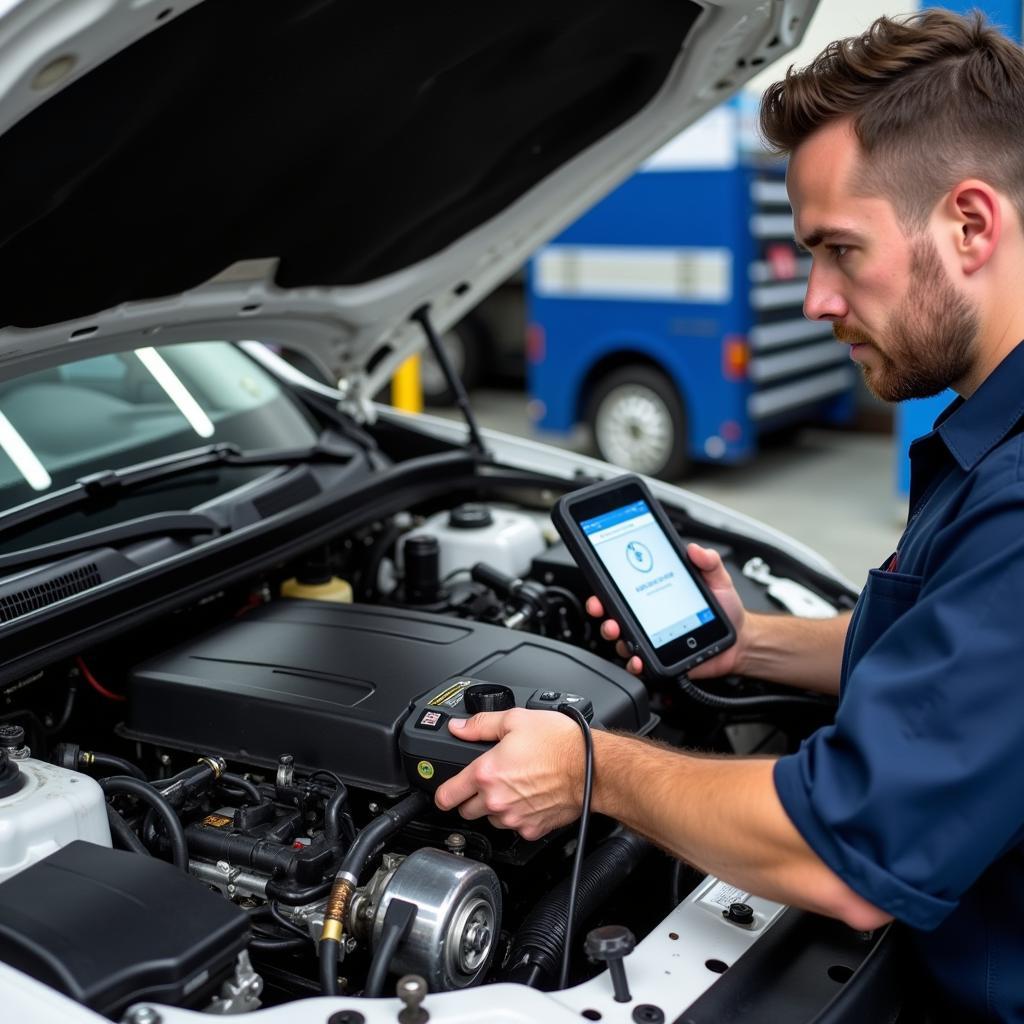Your cart is currently empty!

Understanding and Fixing VCDS P0012 Code: A Comprehensive Guide
“VCDS P0012” – this cryptic code can send shivers down the spine of any car owner. This code, often popping up on your trusty VCDS scanner, indicates a problem with your car’s variable valve timing system, specifically the “A” camshaft timing being over-retarded (Bank 1). While it might sound intimidating, understanding this code and its potential causes can empower you to address the issue effectively.
What Does VCDS P0012 Mean?
The P0012 code specifically points to an issue with the camshaft position, indicating that the “A” camshaft in Bank 1 is not rotating to its intended position as quickly as the engine control module (ECM) expects. This discrepancy can lead to a range of performance issues and should be addressed promptly.
Common Causes of the P0012 Code
Several factors can contribute to the dreaded VCDS P0012 code. Here are some of the most common culprits:
- Low Engine Oil Level/Pressure: Engine oil plays a crucial role in lubricating and actuating the variable valve timing system. Insufficient oil levels or low oil pressure can disrupt the system’s operation, triggering the P0012 code.
- Faulty Timing Chain/Belt: The timing chain or belt ensures the precise synchronization of the crankshaft and camshafts. A stretched, worn, or slipped timing chain/belt can disrupt this synchronization, leading to camshaft timing issues.
- Defective Oil Control Valve (OCV): The OCV controls the flow of oil to the camshaft phaser, responsible for adjusting camshaft timing. A malfunctioning OCV can restrict or completely block oil flow, causing the P0012 code.
- Clogged Oil Passages: Over time, oil passages can become clogged with sludge and debris, hindering oil flow to vital engine components, including the variable valve timing system.
- Faulty Camshaft Position Sensor: The camshaft position sensor relays information about camshaft position to the ECM. A faulty sensor can send inaccurate data, leading to misdiagnosis and triggering the P0012 code.
Troubleshooting the VCDS P0012 Code
 Troubleshooting VCDS P0012
Troubleshooting VCDS P0012
Before diving into repairs, it’s essential to diagnose the root cause of the P0012 code accurately. Here’s a step-by-step guide to help you troubleshoot effectively:
- Check Engine Oil: Start by checking your engine oil level and condition. If the oil level is low, top it up to the recommended level. If the oil appears excessively dirty or contaminated, consider an oil change.
- Inspect Timing Chain/Belt: Visually inspect the timing chain or belt for signs of wear, stretching, or damage. If you notice any issues, consult a qualified mechanic for further inspection and potential replacement.
- Test Oil Control Valve (OCV): The OCV can often be tested using a multimeter to check for proper electrical resistance. Refer to your vehicle’s service manual for specific testing procedures. If the OCV fails the test, it’s likely faulty and needs replacement.
- Check for Clogged Oil Passages: Clogged oil passages often require professional cleaning. If you suspect clogged passages, it’s best to consult a qualified mechanic for diagnosis and cleaning.
- Inspect Camshaft Position Sensor: The camshaft position sensor can also be tested using a multimeter to check for proper signal voltage. Refer to your vehicle’s service manual for specific testing procedures. If the sensor fails the test, it’s likely faulty and needs replacement.
Conclusion
The VCDS P0012 code, while concerning, is not insurmountable. By understanding its meaning and following a systematic troubleshooting approach, you can identify the root cause and implement the necessary repairs. Remember, regular maintenance, including timely oil changes and inspections, can help prevent many of the issues that trigger this code.
If you’re unsure about any step of the troubleshooting process or need professional assistance, don’t hesitate to reach out to our team of expert technicians at +1 (641) 206-8880 and our email address: vcdstool@gmail.com or visit our office at 6719 W 70th Ave, Arvada, CO 80003, USA. We’re here to help you get back on the road with confidence!
FAQs
1. Can I continue driving with a P0012 code?
It’s not recommended to continue driving with a P0012 code as it can lead to further engine damage and reduced fuel efficiency.
2. Is it expensive to fix a P0012 code?
The cost of repair varies depending on the underlying cause. Simple fixes like an oil change or sensor replacement are relatively inexpensive, while more complex repairs like timing chain replacement can be more costly.
3. Can a bad oil filter cause a P0012 code?
While a severely clogged oil filter can restrict oil flow, it’s less likely to cause a P0012 code directly. However, it’s still crucial to use high-quality oil filters and replace them at recommended intervals.
4. How often should I check my engine oil level?
It’s good practice to check your engine oil level at least once a month and before long trips.
5. Can I use any OBD-II scanner to diagnose a P0012 code?
While generic OBD-II scanners can detect the P0012 code, a VCDS scanner provides more detailed information specific to Volkswagen Audi Group vehicles, aiding in accurate diagnosis.
by
Tags:
Comments
2 responses to “Understanding and Fixing VCDS P0012 Code: A Comprehensive Guide”
[…] vcds p0012 is a common fault code related to cam timing, often indicating a correlation issue. […]
[…] of the sensor and its wiring,” says John Miller, a senior automotive electrical engineer at VCDSTool. “Physical damage or loose connections can also trigger similar symptoms and need to be ruled […]
Leave a Reply